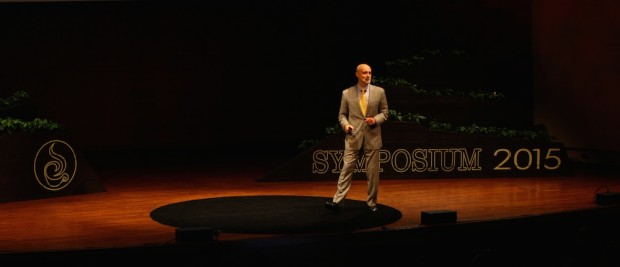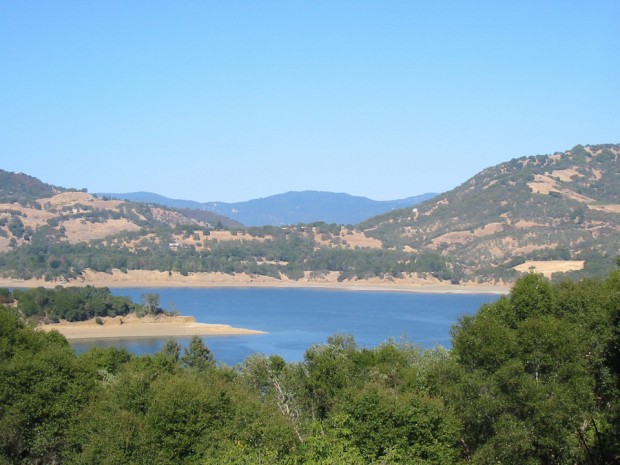
Daniele Giavannucci discussing “The Business of Sustainability” at SCAA Symposium 2015. SCAA Symposium photo.
The 2015 SCAA Symposium (now called Re:Co) played out like an inspiring victory lap. The guiding sentiment: “We were a small niche, the world economy was against us and now we control more than 50 percent of the U.S. market with no sign of stopping.”
The overwhelming sensation of being in a progressive corner of the world, Seattle, surrounded by some of the most intelligent and accomplished minds of the specialty coffee industry was as contagious as it was extraordinary. Curated brilliantly, and in a well-orchestrated TED-like format, we felt the ethos, we shared our data and we enjoyed a sense of solidarity and success. It might actually have been the best coffee event I’ve ever attended, and to my delight, sustainability was a big part of the conversation.
Yet despite all the objective and coherent language we use so precisely in discussions of flavor and “quality” in specialty coffee, the equivalent degree of precision is often not employed in our discussions regarding the sustainability of production — even when we’re talking about the same coffees. The passionate evaluation and careful communication of quality has outpaced the communication of sustainability.
Keeping Up With Consumerism
After the SCAA Event, a colleague and I embarked upon a journey through one of the most beautiful parts of the world: the stretch from Seattle to San Francisco. Along the way we came across an abundance of attractive words and phrases, such as organic, sustainable, direct, artisanal. This language was deployed for the truly amazing coffees we enjoyed along our journey. Just about everywhere we went, we found coffee roasted beautifully and extracted on point, even in the small rural California town of Ukiah. This represents to me the success of immense efforts made by the pioneers of the specialty coffee movement, not only in developing the objective standards that provide a platform for quality, but more importantly, the language with which everyone can communicate that platform.
The point I wish to make is that specialty coffee is not solely about quality. Specialty coffee is a luxury item, a multifaceted and elegant product. When consumers pay more for a cup of specialty coffee, they are treating themselves to a pleasurable but non-essential experience. Increasingly integral to the pleasure of that experience are factors beyond the sensorial, including the intellectual and ethical pleasures of knowing from where the product derives, and how it is developed. In this area, I believe there is plenty of room for improvement.
The first city I visited on my U.S. trip was Nashville, “the fastest growing city in America,” as Nashvillians are quick to inform. One night there, I went to a classic country bar called Tootsies, and ordered a round of beer for my new barista friends. I assumed it wasn’t the kind of place to be ordering fancy microbrews, so I handed my friends what turned out to be the first Bud Light any of them had ever had. This struck me — perhaps revealing how quickly consumer attitudes in America, and to some extent the world, are shifting.
Toward a Coffee-Specific Sustainability Index
Imagine a scenario where a coffee shop serves a 90-point coffee alongside an 88-point coffee on their filter brew bar. What percentage of customers do you think would actually perceive the difference in the quality of their cups between these two carefully and objectively rated coffees? Now, if they were to find out that one of these coffees was picked by starving workers on a poorly-tended farm where the water and soil were being depleted, whereas the other was from a biodynamic farm where workers were treated well, which coffee do you think the customers would prefer?
The reality is that doing the right thing costs more money. The necessary investments of resources, time and money to protect workers and the environment requires that the overall costs of the goods increase at every point along the chain, therefore roasters and their consumers will also have to pay more. It will take abundant transparency and guts to stand by this message, and it is a message that will be better delivered in unison.
As conscientious consumerism continues to rise, and as more people are willing to pay for specialty coffee, we must address the fact that there is far too much confusion surrounding the term “sustainability.” From Seattle to San Francisco we encountered firsthand many brilliant coffee people with widely divergent definitions of this term, especially as it relates to the “sustainability” of coffees from different growing regions.
This confusion, this vagueness among consumers and industry alike, has been a persistent road block for real progress. I contend that the lack of any clear, universal definition of this term, or a widely accepted, quantified index by which real sustainability is measured, is what allows companies to sell products based on ideas that are less than whole, or simply misleading.
Please Discuss
I don’t intend to provide an answer here, but I would like to provoke further dialogue. It is time for people much brighter than I to determine what are the crucial facets of sustainability — the economic and social factors, the impacts on soil, flora and fauna, the workers’ access to education, food, clean water, etc. — how to measure them, and how to communicate these measurements in a clear enough manner that consumers can understand and support the higher-rated products with their dollars. This in turn would provide greater financial incentives for producers and roasters to pursue and communicate sustainability with efforts that are on par with the pursuit of high quality.
No development is sustainable if it results in a decreasing quality of life. A common and objective language — a Sustainability Index score — whereby we measure sustainability in the same exacting, analytical manner as we do with sensorial quality, could go a long way in helping current and future generations fulfill what is truly their obligation: To manage our resources so that the potential for a reasonable quality of life exists for all.
Felipe Croce
Felipe Croce is a coffee producer, exporter and roaster from the group FAFCoffees. He is based in São Paulo, Brazil.
Comment
4 Comments
Comments are closed.








Biodiversity of pollinators would be a good basis. 🙂
I agree with this article. I think my generation, the millennials, have put too much of an emphasis on quality and have consider sustainable buying practices as a second thought. I also experience confusion the world sustainable. I work in city with multiple roasters declaring themselves sustainable, but how sustainable are we compared to each other? This is definitely a topic that needs to be discussed and research.
Good topic to discuss especially as the coffee industry continues to develop. I personally view sustainability for coffee cultivation in two general categories. The first, is what I consider geographical sustainability that involves the ecosystem of plant life, fauna, climate (including climate change), and the land when going about coffee cultivation. The second, is what I consider as socioeconomic sustainability, dealing with the coffee farmers (including their families) and their living and working conditions as well income (and possible benefits) while engaging in coffee cultivation.
Some good Environmental indicators for sustainable (closing of nutrient cycles) coffee production: Carbon sequestration by biomass , diversity of shade trees per hectare, recycling of nutrients (making own organic fertilizers on site) recycling pulp, husk for different solubilization methods for re-intergration of nutrients, such as reproduction of micro-organisms… water quality, design of row planting involving movement of water… fuels used for transportation.. one can do a ecological footprint on the production of coffee